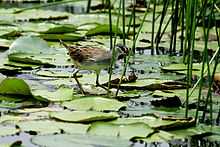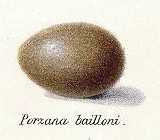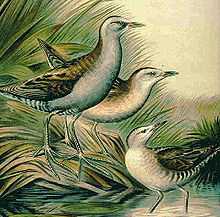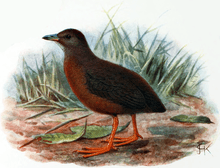Porzana
| Porzana Temporal range: Middle Miocene to Recent 12.6–0Ma | |
|---|---|
.jpg) | |
| Spotted crake (Porzana porzana) | |
| Scientific classification | |
| Kingdom: | Animalia |
| Phylum: | Chordata |
| Class: | Aves |
| Infraclass: | Neognathae |
| Order: | Gruiformes |
| Family: | Rallidae |
| Genus: | Porzana Vieillot, 1816 |
| Diversity | |
| 11 living species Numerous extinct species | |
| Synonyms | |
|
Poliolimnas | |
Porzana is a genus of birds in the crake and rail family (Rallidae). It unites the typical "crakes" found essentially anywhere in the world except desert and polar regions. This genus contains 13 living species, and 4–5 recently extinct ones. In addition, a large number of prehistorically extinct species known only from fossil or subfossil remains have been discovered. Two species are sometimes separated in Poliolimnas as they appear to share some apomorphies. As they are widely allopatric, their similarities may just as well be convergent evolution, and here they are retained in Porzana for the time being.
Description and ecology
These birds are among the smaller members of their family, none being larger than a chicken and some really tiny, smaller than a starling or thrush. Their upperparts are a cryptic lighter or darker brownish hue. The underside is also brown in some, but more often buff or grey. Several species have patterns like whitish dots or black-and-white barred flanks, conspicuous close up, but at a distance providing additional camouflage in these birds' habitat. Some others are rather uniformly blackish-brown all over. The bill and feet are often brightly colored in red to yellow hues; the eyes' iris has some reddish-brownish hue, sometimes being bright red and also very conspicuous at close quarters. Porzana males and females generally differ barely if at all; in the little crake (P. parva), however, they differ so much they might be mistaken for separate species.[1]

Most species of Porzana crakes inhabit wetlands. Some, however, are (or were) found on rocky islands with little water; even these, though, prefer places where abundant vegetation provides a dense ground-cover to hide in. They are usually reclusive and shy, but unlike the larger rails are active and inquisitive birds. When foraging, they will investigate anything that catches their attention and is not considered a predator; in some places, this even includes any humans and their food or equipment that visit these birds' habitat. Their food is mostly small invertebrates – typically arthropods and mollusks – as well as selected plants, seeds and fruit. This is complemented by any small vertebrate they can catch, such as a fish or frog. They can swim if they need to and even dive a bit, but not for extended distances; rather, they prefer to clamber through dense reeds to escape threats, or walk on floating vegetation or just passively drift around a spot when foraging.[1]
As usual for Rallidae, their flight is rather clumsy and their navigation skills and ability to maintain course against the wind are poor; on the other hand, their stamina in the air is exception for their small size; several species migrate thousands of kilometers every spring and autumn, while others originated from wind-blown individuals swept to oceanic islands just as far away from any continent. In this regard, Porzana presently in fact stands supreme among the Rallidae, and even among birds in general it is quite remarkable for its radiation of oceanic island lineages. Gallirallus rivals it in extent, but unlike the cosmopolitan Porzana crakes these rails simply originate in the region next to Oceania and have otherwise not much spread beyond. Porzana species, by contrast, are attested from islands in almost every ocean. As usual for oceanic-island Rallidae, a number of them eventually became flightless due to the rarity of predators on their ocean homes; most of them went extinct from hunting and predation after humans and their accompanying animals reached these islands.[1]

The social and sexual habits of this genus do not markedly differ from the usual standards of their family. They possess the typical complex repertoire of calls, usually quite high-pitched due to the small size (the namesake "crake" calls), but in some situations communicate with a surprisingly deep booming calls. Porzana crakes are monogamous and defend a territory during the breeding season. For the rest of the year, the pairs split and territories are abandoned; pairmates often choose a different partner for the next breeding season. The nest sites are typically in hidden spots at the water's edge, but can be in any dense clump of vegetation between shallow water and dry land as the situation requires. Not much effort is put into building the nest; usually the parents do little more than press down the plants with their bodies. However, the nest cup is carefully lined with soft dry plant material, feathers or hair, which the parents collect specifically for this purpose. The clutch is around 5–10 eggs (a few species have less) whose buffish color is more or less obscured by a rather even and dense cover of brown to purplish dots. The hatchlings are remarkably long-legged and covered blackish down feathers as is typical for rails and crakes. They are precocial and able to leave the nest immediately after recovering from hatching. After a few days they can accompany their parents on long walks, and the nest is soon deserted. After two months or so, the young learn to fly and are able to fend for their own, and have parted ways with their parents. If the pair nests early and/or the clutch fails, they will usually try to raise a second clutch in the same season.[1]
Living species

- Porzana parva Scopoli, 1769 – Little crake (breeds from Central Europe to western Asia, winters in Africa)
- Porzana pusilla Pallas, 1776 – Baillon's crake (breeds from Eurasia to sub-Saharan Africa, Madagascar and Australia, northern birds winter in East Africa and South Asia)
- Porzana porzana Linnaeus, 1766 – Spotted crake (breeds in Europe and western Asia, winters in Africa and India)
- Porzana fluminea Gould, 1843 – Australian spotted crake (Australia)
- Porzana carolina Linnaeus, 1758 – Sora (breeds in North America, winters around the Caribbean)
- Porzana spiloptera Durnford, 1877 – Dot-winged crake (Rio de la Plata region)
- Porzana fusca Linnaeus, 1766 – Ruddy-breasted crake (South to East Asia)
- Porzana paykullii Ljungh, 1813 – Band-bellied crake (East Asia)
- Porzana tabuensis Gmelin, 1789 – Spotless crake (Pacific and adjacent regions)
- Porzana atra North, 1980 – Henderson crake (Henderson Island, SE Pacific)
- Porzana flaviventer Boddaert, 1783 – Yellow-breasted crake (Neotropics) – sometimes in Poliolimnas
Extinct species
Extinct in historic times

- Porzana palmeri Frohawk, 1892 – Laysan rail (extinct 1944)
- Porzana sandwichensis Gmelin, 1789 – Hawaiian rail (extinct c.1890)
- Porzana monasa (Kittlitz, 1858) – Kosrae crake (extinct c. mid-late 19th century)
- Porzana sp. – Lisianksi crake (extinct c.1830s; disputed)
- Porzana nigra J. F. Miller, 1784 – Miller's rail (extinct 18th century, only known from two paintings)
- Porzana astrictocarpus Olson, 1973 – Saint Helena rail (extinct early 16th century)
Prehistoric extinctions

- Porzana keplerorum – Small Maui crake
- Porzana menehune – Liliput crake
- Porzana ralphorum Olson, 1973 – Great Oʻahu crake
- Porzana rua Steadman, 1986 – Mangaia crake
- Porzana severnsi Olson, 1973 – Great Maui crake
- Porzana ziegleri – Small Oʻahu crake
- Porzana sp. – Aiwa Levu crake
- Porzana sp. – Easter Island crake
- Porzana sp. – Great Big Island crake
- Porzana sp. – Great Kauaʻi crake
- Porzana sp. – Huahine crake
- Porzana sp. – Lesser Mangaia crake
- Porzana sp. – Malakula crake
- Porzana sp. – Marquesas crake (Nuku Hiva, Ua Huka; up to 2 species)
- Porzana sp. – Marianas crake (Aguiguan, Rota, Tinian; up to 3 species)
- Porzana sp. – Medium Kauaʻi crake
- Porzana sp. – Medium Maui crake
- Porzana sp. – Small Big Island crake
- Porzana sp. – Ua Huka crake
Ancient fossils
By standards of their family, the fossil record of this genus is not very comprehensive and modestly old. The most ancient fossils that probably belong to the Porzana lineage date from about one dozen million years ago during the Astaracian. A few older fossils of extant rail lineages more or less closely related to Porzana are known, suggesting that older Porzana fossils may also eventually be found. More importantly, the comparatively abundant remains from around 4 million years ago indicate that the genus probably had a cosmopolitan distribution at that time already. The fossils, sorted by age, are:
- Porzana estramosi Jánossy, 1979 (Sajóvölgyi Middle? Miocene – Early Pliocene of Hungary)
- Porzana risilla (Middle Miocene or Middle Pliocene of Mongolia)
- Porzana sp. "QM F23253" (Early Pliocene of NE Australia)[2]
- Porzana sp. "Văršec/Stránská skála" (Late Pliocene of Bulgaria – Early Pleistocene of Czechia)[2]
- Porzana piercei (Shore Hills Late Pleistocene of Bermuda, W Atlantic)
- Porzana cf. flaviventer (Late Pleistocene -? Holocene of Bermuda, West Atlantic)
The Middle Pleistocene fossil described as Porzana auffenbergi is now placed in Rallus.
Notes and references
| Wikimedia Commons has media related to Porzana. |
References
- Taylor, P. Barry & van Perlo, Ber (1998): Rails : a guide to the rails, crakes, gallinules, and coots of the world. Yale University Press, New Haven. ISBN 0-300-07758-0.